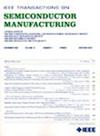通过BF2 + F共植入优化多晶硅电阻器制造:MOS器件中低电阻和高可靠性的制造兼容方法
IF 2.3
3区 工程技术
Q2 ENGINEERING, ELECTRICAL & ELECTRONIC
引用次数: 0
摘要
本文研究了不同能量BF ${}_{2} {+}$ F共注入对MOS器件中多晶硅电阻电学和结构特性的影响。氟的引入有效地降低了多晶硅片电阻10.13%,同时优化了高能量注入时的电阻温度系数(TCR)。用晶界钝化模型解释了氟的加入引起的薄片电阻的降低。FTIR分析显示,由于Si-F键的浓度增加,晶粒尺寸增大,表面粗糙度降低,这一点得到了支持。此外,氟的掺入导致栅极电容的减小和栅极击穿电压的增加。提出了一种新的机制来解释氟通过形成低k SiOF层对栅极电容的影响。此外,更高的氟注入能量通过减轻在不同温度下恒定40 V电应力和热应力下的片电阻漂移,提高了多晶硅电阻的可靠性。本文章由计算机程序翻译,如有差异,请以英文原文为准。
Optimizing Polysilicon Resistor Fabrication via BF2 + F Co-Implantation: A Manufacturing-Compatible Approach for Low Resistance and High Reliability in MOS Devices
This study investigates the impact of BF ${}_{2} {+}$ F co-implantation at various energies on the electrical and structural characteristics of Polysilicon resistors in MOS devices. The introduction of Fluorine effectively reduces the Polysilicon sheet resistance by 10.13% while also optimizing the Temperature Coefficient of Resistance (TCR) at higher energy implantation. A grain-boundary passivation model is used to explain the reduction in sheet resistance caused by the addition of Fluorine. This is supported by evidence of grain size enhancement and surface roughness reduction, attributed to an increased concentration of Si-F bonds as observed through FTIR analysis. Furthermore, the incorporation of Fluorine results in a decrease in Gate capacitance and an increase in Gate breakdown voltage. A novel mechanism is proposed to explain the impact of Fluorine on Gate capacitance by the formation of a low-k SiOF layer. Additionally, higher Fluorine implantation energy improves the reliability of Polysilicon resistors by mitigating sheet resistance drift under constant 40 V electrical and thermal stress at various temperatures.
求助全文
通过发布文献求助,成功后即可免费获取论文全文。
去求助
来源期刊

IEEE Transactions on Semiconductor Manufacturing
工程技术-工程:电子与电气
CiteScore
5.20
自引率
11.10%
发文量
101
审稿时长
3.3 months
期刊介绍:
The IEEE Transactions on Semiconductor Manufacturing addresses the challenging problems of manufacturing complex microelectronic components, especially very large scale integrated circuits (VLSI). Manufacturing these products requires precision micropatterning, precise control of materials properties, ultraclean work environments, and complex interactions of chemical, physical, electrical and mechanical processes.
 求助内容:
求助内容: 应助结果提醒方式:
应助结果提醒方式:


